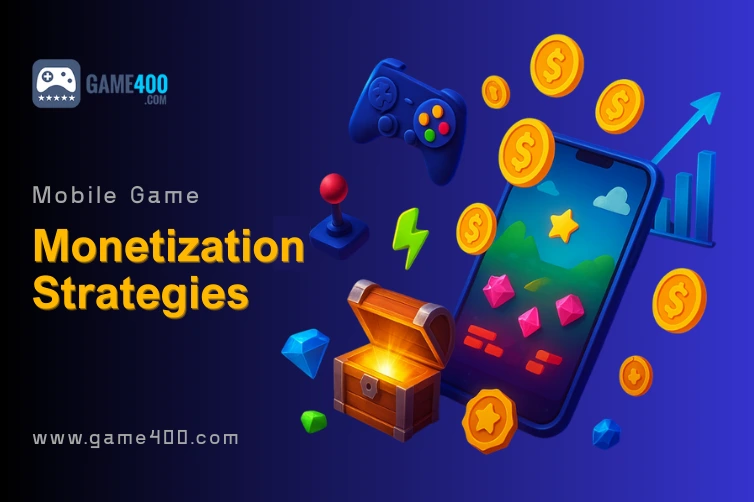Mobile gaming has become a $100+ billion industry, with successful indie developers earning millions through mobile game monetization strategies. Whether you’re building your first game or looking to optimize revenue streams, these proven strategies have helped countless developers achieve seven-figure success.
Free-to-Play Monetization Models
1. In-App Purchases (IAP)
The most lucrative model for mobile games, with Candy Crush generating $1.2 billion annually. Offer power-ups, extra lives, or cosmetic upgrades. Price items between $0.99-$9.99 for maximum conversion rates.
2. Battle Pass System
Games like PUBG Mobile earn $300M+ yearly through seasonal battle passes. Create limited-time progression systems with exclusive rewards at different tiers ($5-$20 price points).
3. Gacha/Loot Box Mechanics
Genshin Impact generates $3 billion using gacha systems. Implement random reward mechanics with guaranteed rare items after specific attempts to maintain player engagement.
4. Premium Currency
Establish dual-currency systems where players earn soft currency through gameplay but need premium currency (purchased with real money) for premium items. Balance is crucial for retention.
5. Cosmetic Monetization
Fortnite’s skin sales prove cosmetics can generate billions without affecting gameplay. Design appealing character skins, weapon designs, and customization options.
Advertising Revenue Strategies
6. Rewarded Video Ads
Integrate 15-30 second video ads that offer in-game rewards. Unity Ads and AdMob report 30-40% higher engagement compared to interstitial ads.
7. Banner Advertising
Strategic banner placement can generate $0.50-$2 eCPM without disrupting gameplay. Position ads during natural pause moments or loading screens.
8. Playable Ads
Interactive ads that let players try other games generate 40% higher click-through rates. Partner with ad networks like IronSource or AppLovin for premium placements.
9. Native Advertising
Seamlessly integrate sponsored content that matches your game’s aesthetic. This approach shows 60% better user acceptance compared to traditional ads.
Premium and Hybrid Models
10. Premium Game Sales
Charge $2.99-$9.99 upfront for premium experiences. Games like Monument Valley earned $30M+ through this model. Focus on high-quality gameplay and unique art styles.
11. Freemium with Unlimited Access
Offer limited free content, then charge $4.99-$19.99 for full game access. This model works exceptionally well for puzzle and strategy games.
12. Subscription Services
Monthly subscriptions ($4.99-$9.99) for ad-free gaming, exclusive content, or premium features. Apple Arcade’s success demonstrates subscription viability in mobile gaming.
Advanced Monetization Techniques
13. Cross-Promotion Networks
Partner with other developers to promote games mutually. This strategy reduces user acquisition costs while maintaining revenue streams through shared advertising.
14. Merchandise and Licensing
Successful games can generate additional revenue through branded merchandise, licensing deals, or spin-off products. Angry Birds earned hundreds of millions through licensing.
15. Esports and Tournament Integration
Create competitive elements with entry fees or sponsored tournaments. Clash Royale tournaments generate significant revenue while building community engagement.
Implementation Best Practices
Start Simple: Begin with 2-3 monetization methods to avoid overwhelming players. Test and optimize before adding complexity.
Focus on Retention: High-retention games monetize better. Implement daily login rewards, progression systems, and social features to keep players engaged.
A/B Testing: Continuously test pricing, placement, and mechanics. Small optimizations can increase revenue by 20-50%.
Analytics Integration: Use tools like GameAnalytics or Unity Analytics to track player behavior and optimize monetization funnels.
Key Success Metrics
- ARPU (Average Revenue Per User): Target $1-$5 for casual games
- LTV (Lifetime Value): Aim for 3x your user acquisition cost
- Conversion Rate: 2-5% of players should make purchases
- Retention Rates: Day 1: 40%+, Day 7: 20%+, Day 30: 10%+
Conclusion
Successful mobile game monetization strategies requires balancing player experience with revenue generation. Focus on providing genuine value through your monetization mechanics rather than exploiting players.
Start with proven models like in-app purchases and rewarded ads, then expand based on your game’s unique strengths. Remember, the most successful games prioritize long-term player satisfaction over short-term revenue spikes.
The mobile gaming industry continues growing, and with the right monetization strategy, your game could join the million-dollar success stories. Begin implementing these strategies today and track your results for continuous optimization.
Ready to develop your mobile game? Check out our guide on choosing the right development framework and explore successful Indian gaming startups for inspiration.



